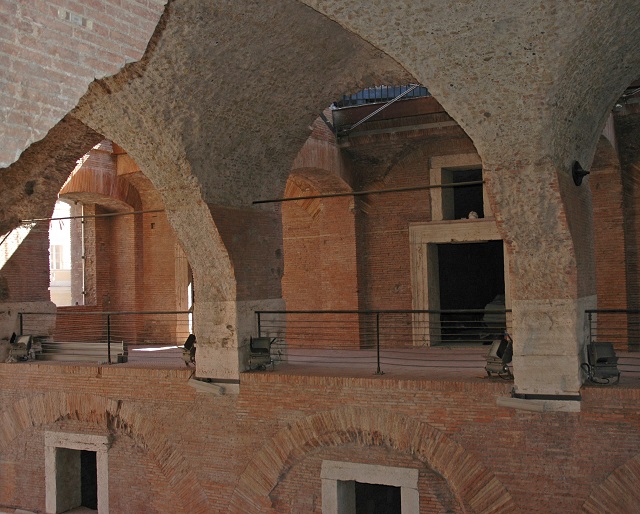 Ancient Roman concrete consists of coarse chunks of volcanic tuff and brick bound together by a volcanic ash-lime mortar that resists microcracking, a key to its longevity and endurance. (Photo by Roy Kaltschmidt, Berkeley Lab)
Ancient Roman concrete consists of coarse chunks of volcanic tuff and brick bound together by a volcanic ash-lime mortar that resists microcracking, a key to its longevity and endurance. (Photo by Roy Kaltschmidt, Berkeley Lab)
An international team of researchers has made an important discovery that helps in understanding the endurance and longevity of ancient Roman concrete monuments. This breakthrough was achieved at the Advanced Light Source (ALS), a research facility at Lawrence Berkeley National Laboratory (Berkeley Lab).
Rome is known for historic sites such as the Colosseum, Trajan’s Markets, Pantheon, and other spectacular Roman architectural monuments, which have endured the test of time for almost 2000 years.
The researchers used a superconducting bending magnet X-ray micro-diffraction beamline called ALS beamline 12.3.2 to study the reproduction of volcanic ash-lime mortar. This mortar, which was subjected to a number of fracture testing experiments, binds cobble-sized pieces of brick and tuff in the walls of Trajan’s Markets. The team observed the mineralogical changes that occurred during the curing of mortar over a span of three months and then compared the results to the ancient original samples. It was found that a crystalline binding hydrate obstructs crack propagation.
Mortars are used to bind the concrete composites, which in turn are used to build the structures of Imperial Rome. These mortars have excellent durability and resilience and also provide significant environmental benefits. Contemporary concretes are adhered by Portland cement that is based on limestone; however, during the production of this cement, clay and limestone are heated to 1,450OC that generates large amounts of carbon, accounting for 7% of the total amount of carbon released into the atmosphere yearly. On the other hand, Roman architectural mortar is a mixture of 85% of lime, volcanic ash, and fresh water. The lime is calcined at lower temperature when compared to the Portland cement. In addition, chunks of volcanic brick and tuff contain 45-55% of the concrete, which contributes to reduced carbon emissions.

Ancient Roman concrete consists of coarse chunks of volcanic tuff and brick bound together by a volcanic ash-lime mortar that resists microcracking, a key to its longevity and endurance. (Photo by Roy Kaltschmidt, Berkeley Lab)
Using ALS beamline 12.3.2, the researchers carried out X-ray micro-diffraction measurements of the Roman mortar slices that measured just 0.3mm thick. Later, they achieved X-ray diffractograms for different points within a specified cementitious microstructure. This helped them to detect variations in mineral assemblages, which accurately indicated the active chemical processes over small areas.
The mineralogical changes revealed the reproduction strength and toughness of the mortar over a period of three months as strätlingite crystals grew in interfacial zones between the mortar matrix and volcanic scoria and calcium-aluminum-silicate-hydrate cementing binder coalesced. The strength of these interfacial zones was seen in the bridging crack morphology, which was determined by means of computed tomography (CT) scans of the fractured mortar samples. These empirical results correspond well with the calculations of increasing fracture energy.
No corrosion was observed in the strätlingite crystals. The smooth surfaces of these crystals imply lasting stability, which is akin to geological strätlingite that endures for many years. The next step for the researchers would be to activate aggregates, such as volcanic ash or slag in novel concretes so that these aggregates develop strätlingite reinforcements in interfacial zones, similar to the Roman mortars.
The mortar resists microcracking through in situ crystallization of platy strätlingite, a durable calcium-alumino-silicate mineral that reinforces interfacial zones and the cementitious matrix, “The dense intergrowths of the platy crystals obstruct crack propagation and preserve cohesion at the micron scale, which in turn enables the concrete to maintain its chemical resilience and structural integrity in a seismically active environment at the millennial scale.
If we can find ways to incorporate a substantial volumetric component of volcanic rock in the production of specialty concretes, we could greatly reduce the carbon emissions associated with their production also improve their durability and mechanical resistance over time.
The in situ crystallization of the strätlingite crystals produces interfacial zones that are very different from any interfacial microstructure observed in Portland cement concretes. High porosity along the interfacial zones of inert aggregates in Portland cement concrete creates the sites where crack paths first nucleate and propagate.
Marie Jackson, University of California Berkeley’s Department of Civil and Environmental Engineering
The study was supported by the Loeb Library at Harvard University and the National Science Foundation.
References